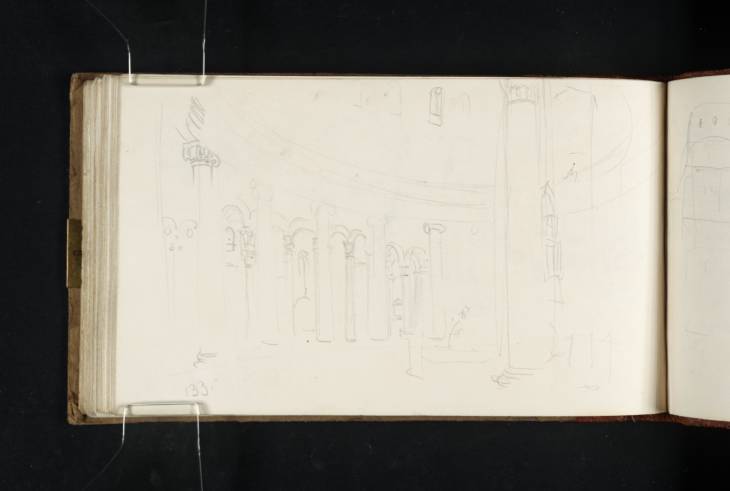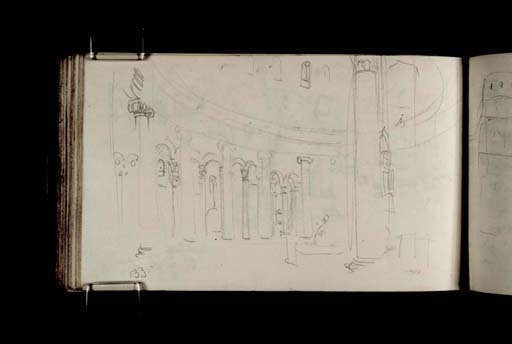Joseph Mallord William Turner Interior of Santo Stefano Rotondo, Rome 1819
Image 1 of 2
Joseph Mallord William Turner,
Interior of Santo Stefano Rotondo, Rome
1819
Joseph Mallord William Turner 1775–1851
Folio 65 Verso:
Interior of Santo Stefano Rotondo, Rome 1819
D15420
Turner Bequest CLXXXII 64 a
Turner Bequest CLXXXII 64 a
Pencil on white wove paper, 113 x 189 mm
Inscribed by the artist in pencil ‘133’ bottom left
Accepted by the nation as part of the Turner Bequest 1856
References
1909
A.J. Finberg, A Complete Inventory of the Drawings of the Turner Bequest, London 1909, vol.I, p.538, as ‘Interior of the Pantheon (?)’.
1984
Cecilia Powell, ‘Turner on Classic Ground: His Visits to Central and Southern Italy and Related Paintings and Drawings’, unpublished Ph.D thesis, Courtauld Institute of Art, University of London 1984, pp.115, 423, reproduced pl.54.
1987
Cecilia Powell, Turner in the South: Rome, Naples, Florence, New Haven and London 1987, p.[41] note 15.
Cecilia Powell has identified this view as the interior of Santo Stefano Rotondo, also known as Santo Stefano Rotondo al Monte Celio, owing to its location on the Caelian Hill. Built between 468 and 483 AD to a cruciform design with a circular core of concentric naves or corridors, the basilica is one of Rome’s most ancient Christian churches.
Turner’s drawing depicts the central high drum of the roof supported by an inner colonnade of Ionic columns, with Corinthian capitals marking the entrance to the church beyond. Powell has argued that the artist chose the one viewpoint from where he could incorporate as many architectural features as possible to relieve the plain interior of the church such as the entrance, the grille window, the altar, an unblocked window in the roof and the only remaining recessed chapel (visible in the centre, to the right of the entrance).1 She also suggests that the inscribed number ‘133’ may refer to the diameter of the building, actually 131 feet.2
One of the most noteworthy features of Santo Stefano is the gruesome cycle of sixteenth-century frescoes by Antonio Tempesta and Niccolo Circignani depicting martyrdoms of various saints. Charles Dickens famously described the paintings in Pictures from Italy, published 1846:
... St. Stefano Rotondo a damp, mildewed vault of an old church in the outskirts of Rome, will always struggle uppermost in my mind, by reason of the hideous paintings with which its walls are covered. These represent the martyrdoms of saints and early Christians; and such a panorama of horror and butchery no man could imagine in his sleep, though he were to eat a whole pig raw, for supper. Grey-bearded men being boiled, fried, grilled, crimped, singed, eaten by wild beasts, worried by dogs, buried alive, torn asunder by horses, chopped up small with hatchets: women having their breasts torn with iron pinchers, their tongues cut out, their ears screwed off, their jaws broken, their bodies stretched upon the rack, or skinned upon the stake, or crackled up and melted in the fire: these are among the mildest subjects. So insisted on, and laboured at, besides, that every sufferer gives you the same occasion for wonder as poor old Duncan awoke, in Lady Macbeth, when she marvelled at his having so much blood in him.3
Nicola Moorby
May 2008
How to cite
Nicola Moorby, ‘Interior of Santo Stefano Rotondo, Rome 1819 by Joseph Mallord William Turner’, catalogue entry, May 2008, in David Blayney Brown (ed.), J.M.W. Turner: Sketchbooks, Drawings and Watercolours, Tate Research Publication, December 2012, https://www


